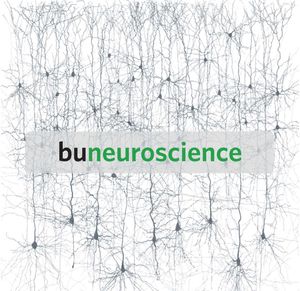Hey Scientists, Where’s My Jetpack?! : The future is here; it just looks a little different than expected
In almost every major futuristic science-fiction work of the last century, jetpacks and flying cars are seemingly as ubiquitous as today’s oversized SUV’s, lining the closets and garages of every hardworking American. Understandably, in the year 2011, this has lead many disenchanted Trekkies and purveyors of assorted geek cultures to ask, “Well, scientists, where’s my jetpack?!” While I commiserate with my fellow fans of Asimov and Adams, several recent innovations have led me to believe that we all might be overlooking just how “futuristic” the time we live in really is. Accessing Google on the iPhone is certainly as close to the Hitchhiker’s guide to the galaxy as we may ever come. We have the ability to beam blueprints of intricate plastic objects and now even organs anywhere in the world and literally print them out. We have computers that can beat us in Jeopardy! And last but not least, Ladies and Gentlemen, I present to you Brain Driver, the thought-controlled car. On behalf of scientists everywhere, I accept your apologies, geeks. More
More Shirts…
Here are two more renditions of shirts for BU Neuroscience. Please VOTE!!
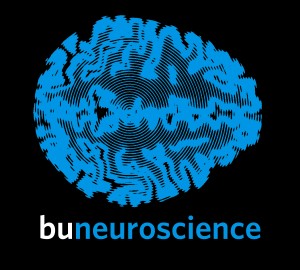
D.C. Somers
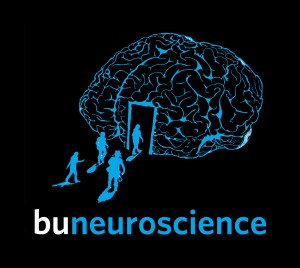
Devyn Buckley
The Psychology of Facebook
Psych Central’s April Fool’s Day Joke for 2011 was an article that read: “Facebook Revealed to be Psychology Experiment Gone Wrong.” The author used a fake source of Harvard University and several quotes from ‘professor of psychology’ Mark Zuckerberg. This article seemed pretty believable...for about a day.

The researchers behind this project claimed to be interested in “whether or not people in the class would immediately become competitive and try and gain as many friends as possible.” And though this research experiment is far from the truth, the psychological implications of Facebook are certainly a reality.
Rishi Bandopadhay of PsyBlog equated Facebook networking to a competitive sport. He listed 7 rules to ‘get ahead’ using Facebook.
- Get between 100 and 300 friends. (You don’t want to look like a loner, or like you are trying too hard)
- Court attractive friends (Walther et al. (2008) found that attractive friends boosted the perceived attractiveness of participant's profiles)
- Understand the 7 motivations (Joinson (2008) found 7 basic motivations for using Facebook: connecting with old or distant friends, social surveillance (see what old friends are up to, but without talking to them), looking up people met offline, virtual people watching, status updating and content)
- Don’t let your partner use Facebook (Muise et al. (2009) found that the more time spent on Facebook, the more jealousy)
- Guard your privacy
- Display your real self
- Use Facebook to get a job
Is Facebook really this competitive? I can’t remember the last time I noted how many Facebook friends someone had or judged their popularity by their friends’ good looks. Facebook can also tell you a lot about someone’s personality.
Buffardi and Campbell of the University of Georgia found that individuals’ level of activity on their social networking website is strongly correlated to their level of narcissism; this finding is relatively obvious. It’s easy to see which friends of ours, whose ‘activities’ constantly show up on our newsfeed, are self-centered.

Next Orr, Sisic, Ross, Simmering, and Arseneault set out to study correlations of shyness to various aspects of social networking websites. They found that shy people spend considerably more time on Facebook than people who are not; however, these shy people also had considerably fewer friends, despite their increased time spent on Facebook. So the quiet kid who sits in the back of your Statistics class has probably Facebook stalked you, but you’ll never be receiving a friend request because that person does not have the guts to hit “Send Request.”
Psych Central- Facebook Revealed to be a Psychology Experiment Gone Wrong
PsyBlog- Facebook: 7 Highly Effective Habits
The Layman's Guide to Psychology- The Psychology of Twitter, Facebook, and other Social Networking Devices
New Class of Cognitive Enhancers to Transform Mankind
Scientists at the Bewundgen University in Germany discovered that a diet rich in petrolatum, a substance of hydrocarbons, can greatly improve performance on a wide variety of cognitive tasks.
The research, led by neuroscientist Dr. Hans Schweinstucken, followed three groups of human subjects for over a year. The first group was instructed to eat regularly, but to also consume 500 grams of petrolatum per day, in the morning after breakfast. The second group was given an energy-deficient supplement of sugar substitutes; and the third were not given anything at all. All groups were tested periodically on tasks of memory, abstract thinking, cognitive speed, and general agility. To their surprise, the researchers found that regular consumption of petrolatum improved subjects' recall, memory retrieval and abstract thinking while reducing overall agility, motivation and ability to make decisions. In contrast, the group eating sugar substitutes performed significantly worse over time on tests of memory and abstract thinking, with 50% of the subjects hitting an all-time low of 25% correct responses on recall (vs. their performance prior to the experiment).
Dr. Schweinstucken speculates that the first group's reduced motivation and agility may have something to do with their major weight gain, which by itself remains a mysterious side-effect. As for the mechanisms of action, Dr. Schweinstucken proposes that petrolatum acts via inhibitory GABAergic interneurons in neocortex, the brain part thought to be important in higher cognition, antagonizing GABA action and thereby reducing overall levels of inhibition in the brain. However, he warns that at higher doses than 500 grams per day, petrolatum may actually have a detrimental effect on cognition because it may saturate GABA receptors and the corresponding neurons, causing massive seizures; he is currently conducting experiments to test this hypothesis.
Meanwhile, for all you folks who have exams to study for, I recommend a trip to your local CVS, where petrolatum is sold over-the-counter as "Vaseline," or petroleum jelly.
Further reading:
Schweinstucken et al. Petrolatum improves cognitive performance in humans. J Psycho Chemo Physio Med. 2011, April 1.
Can the Mind Control the Brain?
Research has been conducted that proves that our thoughts can control the rate of firing of neurons in our brain. This research reveals the crucial advancement of brain-operated machines in the field. John P. Donoghue at Brown University has conducted research that uses neural interface systems (NISs) to aid paraplegics. NISs allows people to control artificial limbs; individuals simply need to think about commanding their artificial limbs and signals are sent down from their brain to control the movement of these limbs! This great feat is not the only applicable result of current research done by brain-machine interfaces. Dr. Frank Guenther of Boston University uses implanted electrodes in a part of the brain that controls speech to tentatively give a voice back to those who have been struck mute by brain injuries. The signals produced from these electrodes are sent wirelessly to a machine that is able to synthesize and interpret these signals into speech. This is specifically useful for patients suffering from locked in syndrome, wherein an individual with a perfectly normal brain is unable to communicate due to specific brain damage, and thus allowing these individuals to communicate with the world! These discoveries are not only incredibly useful, but they also reveal the astonishing feats that the field of computational neuroscience is accomplishing in the world today.
On-line, voluntary control of human temporal lobe neurons
I <3 Kim Kardashian
They can’t stop talking about her. “Look at how popular and successful she is!” “Look at how stupid and ditsy she is!” “What has she done to be so famous?” … Well, I don’t care if she’s smart or stupid, rich or poor. The only things I see when she’s on the screen are those voluptuous curves. Regardless of what you think of her, Kim Kardashian has what most men dream of. Since this is a nerds’ blog, we’re going to take the moment to examine why we men like those curves so much.
Men like women with large curves because these provide an adaptive advantage, increasing the likelihood of the propagation of genes. Wide hips are adaptive because they make child birthing easier (more successful); large breasts may provide more nutrition during nursing. The men who go for the curves are more likely to make successful offspring; those offspring incidentally share the same instinct for curves and eventually make more progeny; and the cycle continues.

Now, Kim Kardashian is what you call a supernormal stimulus. She has everything that normally elicits a positive response but exaggerated. “Supernormal stimulus,” by the way, is attributed to the famous ethologist Niko Timbergen, who found that substituting a mamma-seagull’s white beak with its one red spot for a stick with three red spots made the chicks way more excited for food. Many more such examples have been described in a variety of animals. More
Genome or Connectome?
Sebastian Seung is a professor of computational neuroscience and physics at MIT. His research in the neuroscience field involves "connectomes," or the map of connections between and among neurons. The endeavor of investigating and mapping connectomes began in the 1980s and jumped off with the elucidation of the complete connectome of the worm C. elegans in 1986. While C. elegans has about 300 neurons, humans have about 10 billion neurons and ten times that number of connections. These connections can grow and change with and from neural activity and experience, combining to permutations exponentially greater that those of DNA and its four bases. Seung proposes that we "are our connectomes" rather than our genomes, implying that our thoughts, experiences, emotions, and consciousness itself may have a purely neural basis. To refrain from any more spoilers, he artfully expands and explains his hypothesis in the above TED talk that it is surely worth viewing. For a greater philosophical inquiry inspired by his ideas, is our matter all that matters?
Infectious Emotions?
Biological systems, such as the circulatory, respiratory, and nervous systems, are groups of organs that function together to perform a common task. Some can also participate in crosstalk with other organ systems. The respiratory system, for example, brings in the oxygen that the circulatory system delivers to all the cells of the body, and maintains blood pH. The endocrine and nervous systems are signaling systems that facilitate communication between different parts of the body by use of hormones and neurotransmitters, respectively. These connections are numerous and complex, but it was previously thought that the immune system and the nervous systems were separate and largely autonomous.
In June 2010, Mauricio Vargas and colleagues from Stanford University School of Medicine reported research in Proceedings of the National Academy of Sciences showing that endogenous antibodies play an important role in repairing peripheral nervous system (PNS) damage. Antibodies are a principal part of the adaptive immune response to infection, but this research suggested that antibodies are also able to clear degenerating myelin which inhibits axon regeneration, akin to a homeostasis function. This repair was only present after PNS injury, whereas myelin debris remained in the central nervous system (CNS) white matter for years. The well known blood-brain barrier concurs with this separation in responses, as it is understood to be impermeable to large proteins such as antibodies.
Various new studies, howeve r, have shown that behavior, mood, and memory can all be influenced by aspects of the immune system, suggesting that antibodies can somehow infiltrate the brain.
r, have shown that behavior, mood, and memory can all be influenced by aspects of the immune system, suggesting that antibodies can somehow infiltrate the brain.
Sammy Maloney was a happy and outgoing 12-year-old boy. In 2002, however, his mother started to notice curious deviations in his personality. In six months, he underwent complete mental deterioration and was diagnosed with obsessive compulsive disorder and Tourette’s syndrome. Shortly afterwards, he was found to be harboring a streptococcal infection, although he exhibited no physical symptoms of one. Interestingly, when he started taking the prescribed antibiotics, his behavior markedly improved.
Madeline Cunningham at the University of Oklahoma has spent several years investigating various behavioral disorders associated with streptococcal infections. Cunningham has shown that antibodies against one group of streptococcal bacteria are able to bind to a site in the brain that controls movement, and consequently trigger the release of dopamine. This could explain the emotional disturbances associated with these types of disorders (1).
Studies also suggest that an activated immune system has other perceivable effects on the nervous system. For example, Jonathan Kipnis of the University of Virginia and his colleagues have shown that learning triggers a stress response in the brain, which causes CD4 cells, a type of T lymphocytes, to gather at the meninges and release interleukin-4. IL-4 switches off the stress response and causes a release of brain-derived neurotrophic factor, which facilitates memory formation. Interestingly, cancer p atients treated with chemotherapy drugs often experience various cognitive defects and some memory loss. This is commonly called “chemobrain”, and these studies raise the possibility that it is a consequence of immunosuppression. Finally, an immune response against Mycobacterium vaccae has been shown to improve mood by causing neurons in the prefrontal cortex to release excess seratonin.
atients treated with chemotherapy drugs often experience various cognitive defects and some memory loss. This is commonly called “chemobrain”, and these studies raise the possibility that it is a consequence of immunosuppression. Finally, an immune response against Mycobacterium vaccae has been shown to improve mood by causing neurons in the prefrontal cortex to release excess seratonin.
So it could be that the blood-brain barrier is kind of leaky after all. Understanding the connections between the immune system and the brain could lead to all sorts of ingenious treatments for various disorders. Perhaps those scientists at Stanford will utilize antibodies to develop a treatment for central nervous system repair. Perhaps we’ll one day be faced with immuno-emotive treatments for depression. Who knows? Anything is possible when a long-standing “truth” turns out not to be absolute - I'm optimistic since scientific advancement is often built on the refinement of prior knowledge.
Happiness is Catching - New Scientist
Endogenous Antibodies Promote Rapid Myelin Clearance and Effective Axon Regeneration after Nerve Injury - Proceedings of the National Academy of Sciences
Previous The Nerve Blog post About PNAS Article
Footnote:
(1) Antibodies raised against the Streptococcal M protein and human myocardial tissue, and Guillain-Barre syndrome in response to Campylobacter infection, are well studied examples of cross-reactivity between anti-pathogen antibodies with host tissues.
Neuroscience Shirt Designs!
BU's Mind and Brain Society is choosing among three (so far!) shirt designs to represent neuroscience at BU. Here they are! Please comment on which you like best!
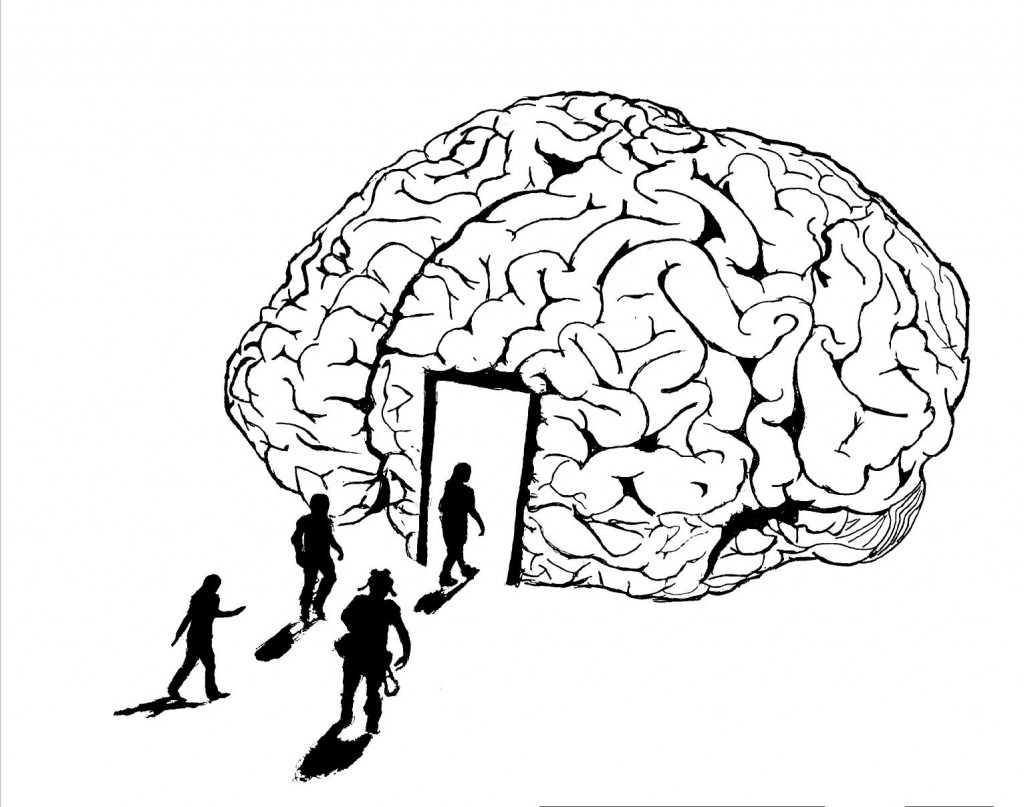
by Devyn Buckley
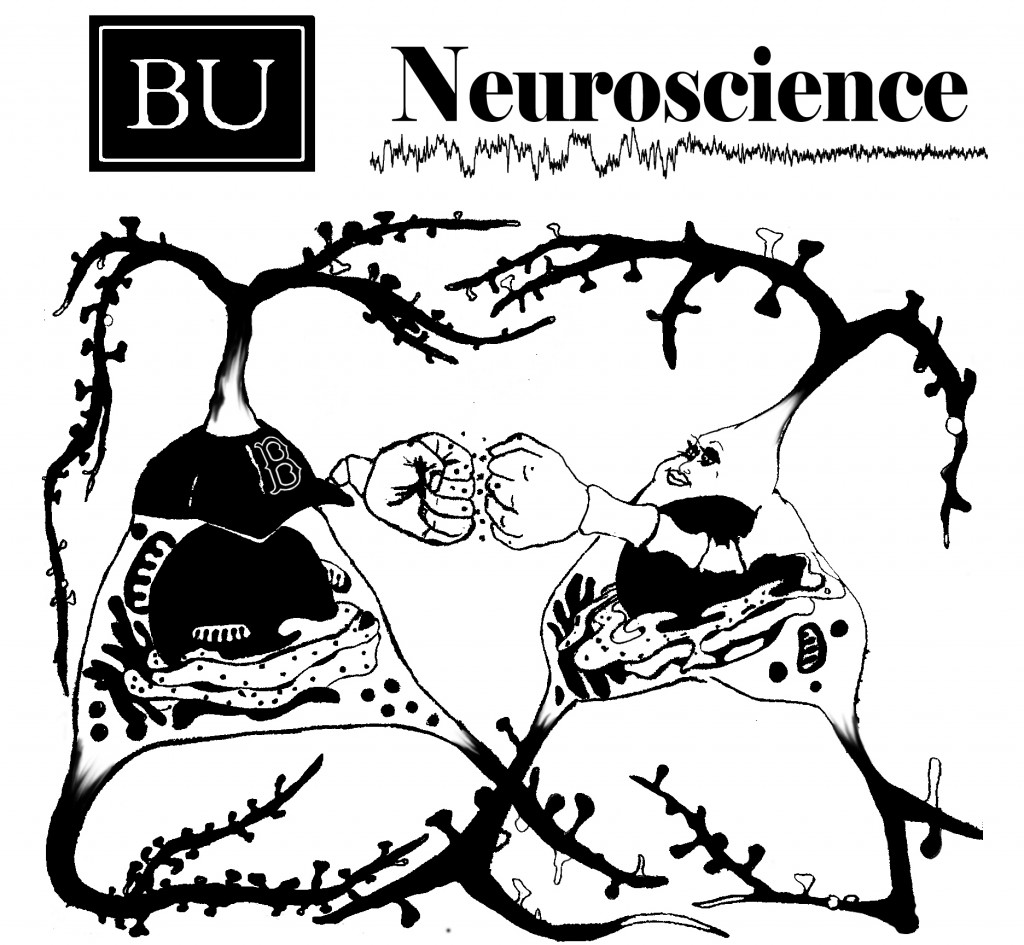
by Sam Mckenzie
